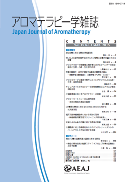We investigated the distribution of tocopherols, including α-, β-, γ-, and δ-tocopherols, and phytosterols, including campesterol, stigmasterol, and β-sitosterol, in 117 kinds of commercial essential oil, using selected ion monitoring mode (SIM), by gas chromatography-mass spectrometry. Tocopherols and phytosterols are widely known to have functional properties such as antioxidation, prevention of skin cornification, and anti-inflammation and anti-cancer actions. We detected tocopherols and/or phytosterols in 46 of the essential oils. Phytosterols also have the potential effect of depressing serum cholesterol. We detected a predominantly high tocopherol content in absolutes obtained from flowers such as lotus (Nelumbo nucifera), fragrant olive (Osmanthus fragrans), damask rose (Rosa damascene), broom (Spartium junceum), and jasmine sambac (Jasminum sambac). We found a high phytosterol content in absolutes from flowers such as lotus, violet (Viola odorata), and fragrant olive. Among the cold-pressed oils of citrus fruits, we encountered a notably high tocopherol and phytosterol content in yuzu (Citrus junos). Among steam-distilled essential oils, we detected tocopherols and/or phytosterols in 23 samples. In 71 essential oil samples we encountered neither tocopherols nor phytosterols. These results suggest that some essential oils show potential for providing additional functional properties to the fields of aromatherapy, perfumery, and cosmetics.
View full abstract
